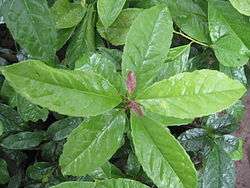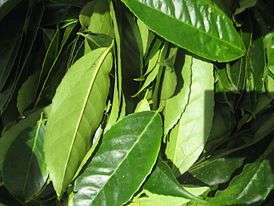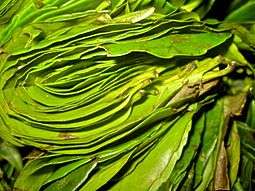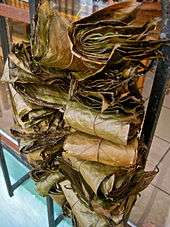Ilex guayusa
| Ilex guayusa | |
|---|---|
 | |
| Ilex guayusa | |
| Scientific classification | |
| Kingdom: | Plantae |
| (unranked): | Angiosperms |
| (unranked): | Eudicots |
| (unranked): | Asterids |
| Order: | Aquifoliales |
| Family: | Aquifoliaceae |
| Genus: | Ilex |
| Species: | I. guayusa |
| Binomial name | |
| Ilex guayusa Loes. | |
Ilex guayusa (/ˈaɪlɛks ˈɡwaɪjuːsə/ or /ˈaɪlɛks ˈwaɪjuːsə/) is a species of tree of the holly genus, native to the Amazon Rainforest.[1] One of three known caffeinated holly trees, the leaves of the guayusa tree are dried and brewed like a tea for their stimulative effects.[2]
Description

Ilex guayusa is an evergreen dioecious[3] tree which grows 6–30 meters tall.[4] The leaves are ovate, elliptic, oblong or lanceolate; 7–22 cm long, 2.5–7 cm wide.[4] The flowers are small and white, arranged in thyrses.[4] The fruit is spherical and red, 6–7 mm in diameter.[4]
Distribution and Habitat
A tall tree native to the upper Amazonian regions of Ecuador, northeastern Peru, and southwestern Colombia, between 200–2000 meters of elevation.[1][4] It is present in evergreen or deciduous premontane forests, especially ones dominated by Dictyocaryum palms.[4] Guayusa has been collected only rarely in the wild by botanists and is known almost exclusively as a cultivated plant (especially in the Ecuadorian provinces of Napo and Pastaza).[5]
Vernacular names
Wayusa as pronounced in the indigenous Kichwa (or Runashimi) is one of the many languages spoken by numerous indigenous nations in the Ecuadorian Amazon. Also pronounced "Why-sa" by the Kichwa people and "Why-ees" by the Shuar people.
History
A 1,500-year-old bundle of guayusa leaves was found by Harvard University ethnobotanist Richard Evans Schultes in a medicine man's tomb high in the Bolivian Andes, far beyond the natural range of the plant.[6]
Cultivation and use
After harvest, the guayusa leaves are dried which allows flavor to develop.[5][7]

Traditionally, some Ecuadorian Kichwa people boil guayusa leaves in water and consume the resulting beverage for its stimulative effects.[5] In addition to drinking cups of guayusa like many Americans drink coffee, indigenous hunters drink guayusa to sharpen their instincts and call it the “Night Watchman" because it helps them stay alert and awake all night.[8] Fresh leaves are used as well as dried leaves, which are dried in rolls and strung together as a wreath resembling a Hawaiian lei.
In 2015, Runa Foundation carried out an extensive study on the uses and history of the plant amongst various indigenous groups throughout Colombia, Ecuador, and Peru which was published in Economic Botany in 2016,[9] and which concludes with:

In relation to the therapeutic uses of guayusa, we acknowledge that available museum records and accounts have not always been verified to ensure they actually refer to I. guayusa, or to a different species with similar uses. Meanwhile, I. guayusa’s stimulating and medicinal properties will continue to position it as a valued species of the Andean–Amazonian interface, especially given intensification of market–oriented guayusa production in recent years.[9]
Chemical composition and properties
Guayusa yields xanthines such as caffeine. Other holly species with significant caffeine content are Ilex paraguariensis, or yerba mate, and Ilex vomitoria, or yaupon holly.
In addition to caffeine, guayusa also contains theobromine, commonly found in chocolate, and L-theanine, a glutamic acid analog also found in green tea.[10]

Chemical analyses in 2009 and 2010 have shown caffeine content in guayusa of 2.90-3.28% by dry weight.[11][12]
Myths and legends
Michael Harner, the founder of the Foundation for Shamanic Studies describes how “the Jivaro say guayusa is so habituating that before it is offered to a visitor, he is warned that once he drinks it, he will ever always after return to the Ecuadorian Jungle.”[13]
The Kichwa people claim that guayusa induces dreams that foretell whether hunting expeditions will be successful.[14]
See also
- Yerba mate (Ilex paraguariensis) - South American caffeinated holly species used to make Mate.
- Yaupon Holly (Ilex vomitoria) - southeastern North American caffeinated holly species used to make the Black Drink.
- Kuding (Ilex kudingcha) - Asian holly species used with Ligustrum robustum for Chinese kǔdīng chá tea.
References
- 1 2 "Tropicos | Name - Ilex guayusa Loes.". www.tropicos.org. Retrieved 2016-01-25.
- ↑ http://news.nationalgeographic.com/news/2014/07/140703-guayusa-ecuador-amazon-health-foods-tea/
- ↑ Shemluck, Melvin (1979). "The flowers of Ilex guayusa" (PDF). Botanical Museum Leaflets. Harvard University Herbaria. 27 (5/6): 155–160.
- 1 2 3 4 5 6 Loizeau P.-A.; G. Barriera (1 March 2007). "Aquifoliaceae of Neotropics Ilex guayusa Loes.". Monographia Aquifoliacearum. Retrieved 2 August 2011.
- 1 2 3 Lewis, WH; Kennelly, EJ; Bass, GN; Wedner, HJ; Elvin, L (May–June 1991). "Ritualistic use of the holly Ilex guayusa by Amazonian Jivaro Indians". Journal of Ethnopharmacology. 33: 25–30. doi:10.1016/0378-8741(91)90156-8.
- ↑ Wassén, S. H. (1972). "A medicine-man's implements and plants in a Tiahuanacoid tomb in highland Bolivia.". Etnologiska Studier. Goteborgs Etnografiska Museum. 32: 8–114.
- ↑ "Processing". Runa. Retrieved 2011-07-21.
- ↑ "Cultural Heritage". Runa. Retrieved 2011-07-21.
- 1 2 Duenas, Juan; et al. (February 2016). "Amazonian Guayusa (Ilex guayusa Loes.): A Historical and Ethnobotanical Overview". Economic Botany (XX(X) 2016): 1–7.
- ↑ "Lab Number:056939". Advanced Botanical Consulting & Testing, Inc. Retrieved 2011-07-21.
- ↑ "Lab Number:056939". Advanced Botanical Consulting & Testing, Inc.
- ↑ "Componentes Quimicos Guayusa 19Oct09".
- ↑ Harner, Michael The Way of the Shaman: A Guide to Power and Healing. Harper & Row, 1980. http://www.scribd.com/doc/59959885/The-Way-of-the-Shaman-Harner-OCR-Edition-Resistance-2010. ISBN 0-553-20693-1
- ↑ Spruce, R. (1996). Notas de un botánico en el Amazonas y los Andes. Quito, Ecuador: Colección Tierra Incógnita.
External links
- Fundación Runa - Guayusa as a Tool for Sustainable Development and Forest Conservation
- Guayusa, a neglected stimulant from the eastern Andean foothills